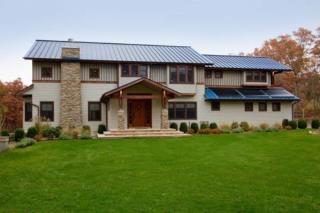HGA House
USGBC Awards Southampton’s HGA House LEED® Platinum Certification
4,800 Sq. Ft. Home One of Largest LEED Platinum on Record - Fire-Destroyed Home Receives USGBC’s Highest Certification
37 Parkside Avenue in Southampton, known as “HGA House” was awarded LEED platinum certification by U.S. Green Building Council (USGBC) for achievement in green homebuilding and design. The HGA House is owned by David and Saundra Dubin, who were devastated when their original home was destroyed by fire in late 2009. Today, they are thrilled that their home may be among the top largest green homes in the country. “As a LEED-certified home, HGA House serves as a model of greener living for the entire community”
Innovative green building is transforming the world for a better future and we are doing it one home at a time.
The Dubins will have architects Ric Stott, Craig Lee and the Hamptons Green Alliance (HGA) to thank for their newly rebuilt and designed home, which has risen from the ashes to become a model of net zero energy carbon neutral green building.
“In combination with architects Stott and Lee, we, at the Hamptons Green Alliance, are very proud to have been a part of such an inspiring project,” says Frank Dalene, who is the co-founder of the HGA and the president of Telemark. “Innovative green building is transforming the world for a better future and we are doing it one home at a time.” Telemark served as general contractor for the project.
“As a LEED-certified home, HGA House serves as a model of greener living for the entire community,” said Nate Kredich, Vice President of Residential Market Development for the USGBC. “The home sets the example that we can all live better by reducing our environmental footprint, cutting our utility bills, and coming home to a greener place to live.”
What sets HGA House apart is its size. The HGA House combines LEED Platinum, net zero energy, and carbon neutral building in a 4,800 square foot luxury home renovation. The home’s carbon footprint was successfully measured by ICEMAN, which was developed by Frank Dalene to provide a possible solution to the challenge of quantifying carbon neutrality.
Along with Telemark, HGA assembled a team of green craftsmen and suppliers to develop a plan for the HGA House. The team integrated multiple means, methods of design and construction to achieve maximum efficiencies – a term that they have coined, “Systems Integrated Home.” Implementing the team’s Systems Integrated Home approach, HGA House achieved a 104 Home Energy Rating System score from the USGBC. For a home to be rated as LEED-Platinum, the highest award offered, it must score at least 90 points.
Among the HGA House Highlights are:
- Passive features from the architect’s design such as increased soffits to maximize solar gain in winter and maximize shading in summer
- A south facing orientation
- High efficiency windows
- Spray foam insulation – low expansion foam around windows, doors
- HERS Rating 25 was achieved – tests check for air leakage in ducts and the house; all ductwork in conditioned space and sealed; all joints caulked to decrease air infiltration
- Low Flow fixtures and dual flush toilets
- A rainwater harvesting tank to collect rainwater from gutters for irrigation
- LED lighting using 85% less energy than conventional bulbs and designed to last for 50,000 hours
- Smart house technology including LED screens on first and second floor to monitor house readings; programmable systems that turn on and off should an alarm sound; all rooms pre-wired for future programming; home energy monitoring
- A high efficiency wood burning fireplace to provide clean and efficient burning to minimize heat loss – the fireplace produces 50,000 BUT/hr.
- Energy Star appliances and electrical systems
- Geothermal system – open loop, two stage, variable speed with all ductwork insulated and sealed
- Solar thin film on the south facing part of house
- Solar panels on the east and west facing roof
- Solar thermal – for summer mode to provide domestic hot water and heat dump for pool heat mixing with the return water from the pool; the winter mode also supplies domestic hot water with the excess hot water going through hot water heating coils to distribute heat through the ductwork to heat the house as a primary heat source.
New technologies were integrated into the house including:
- LED lighting – CREE LR-6 high hats using only 12.5 watts of input power to deliver 1000 lumens, the LR6-DR1000 has unmatched fixture efficacy of up to 80 lumens per watt. It consumes half the energy of a typical CFL down light while delivering the same light output.
- Micro inverters for solar thin film photovoltaic
- Building integrated photovoltaics
- Solar thermal winter mode heat dump
- Whole house monitoring system
About LEED®
The LEED® (Leadership in Energy and Environmental Design) Green Building Rating System™ is a feature-oriented rating system that awards buildings points for satisfying specified greenbuilding criteria. The six major environmental categories of review include: Sustainable Sites, Water Efficiency, Energy and Atmosphere, Materials and Resources, Indoor Environmental. Quality and Innovation and Design. Certified, Silver, Gold, and Platinum levels of LEED green building certification are awarded based on the total number of points earned within each LEED category.
To learn more about LEED, Click here.

